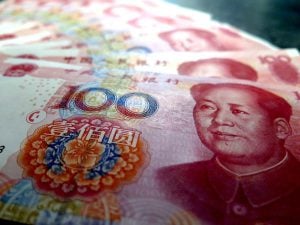Earlier this month, the Luxembourg and New York branches of the Bank of China launched US$3 billion in dollar, euro and renminbi-denominated green bonds, to be traded in both Luxembourg and Hong Kong. This was the largest, multi-denominated issue of green bonds on international markets so far.
Green bonds are fixed financial instruments issued by governments, multi-national banks or corporations to raise money for an environmental purpose .The issuing entity guarantees to repay the bond over a certain period of time, plus either a fixed or variable rate of return.
Typically, third-party groups track issuers for the life of green projects and initiatives, thus keeping them accountable for certain standards.
These types of financial instruments are viewed as particularly critical for China to scale up funding to pay the costs of cleaning up the country’s chronic pollution problem and switching to clean energy, which are estimated to be trillions of yuan.
In the first half of this year, Chinese-funded entities (governments, banks and companies) issued US$11.2 billion (75 billion yuan) in green bonds, 33% of the global total during the period. The total value of green bonds issued or approved, including in offshore markets, now stands at 143.65 billion yuan (about US$21.5 billion), making it the fastest-growing and most attention-grabbing player in the global market.
However for green bonds to have environmental credibility, third-party certification is essential for market development, and that “greenwashing” must be prevented from the very start, says Ma Jun, chief economist at the People’s Bank of China’s research bureau and one of the main architects of the green bond market in China.
On the international markets, third party certification bodies are varied, but include academic institutions, auditors, evaluation bodies and social responsibility consultants.
Building trust in this market is viewed as highly desirable, maybe even essential if China and other countries are to raise the finance required for greener growth and low carbon transition in the so-called “Year of Green Finance”.
Next month, in Hangzhou, China will host a meeting of the G20 group of the world’s most powerful economies, where green finance is expected to be high on the agenda.
Many investors who look primarily at the actual returns and risk are calling for policy support – in particular for standards on a third party certification.
Such a system would bring transparency to how funds raised via green bonds are to be used and balance the associated rights and responsibilities. There is currently an urgent need for better information disclosure.
Internationally, regulation of green bond markets is gradually improving. In 2014 the International Capital Markets Association launched, in association with numerous financial institutions, the Green Bond Principles – the first widely accepted voluntary code of conduct on international markets. That document was updated in June 2016, and sets out the basic framework for green bonds, recommending the issuers use third-party certification to ensure bonds meet standards, and supporting the development and use of third-party standards.
China is also actively exploring this field. While increasing investor numbers and encouraging private capital investments in energy-saving and emissions-reduction through appropriate policy support, it is also providing stronger mechanisms, bolstering information disclosure and building third-party systems, as the country seeks to take on greater responsibility in the development of global green bond markets.
Green bonds have appeared in the international markets in response to concerns responsible investors have about the exposure of companies to climate change (both in terms of low carbon policies from governments and the impacts of extreme weather events). Investors are also taking greater heed of broader environmental issues, such as pollution of air, soil and water, and the overuse and depletion of natural resources.
Green bonds first appeared in 2007, with growth accelerating particularly fast in the last few years, as companies seek more environmental finance in their portfolios. Initially green bonds were issued only by multilateral financial institutions such as the European Investment Bank, the World Bank and the International Finance Corporation, and state-backed financial institutions but now a slew of companies have got involved, including US tech giant Apple, which raised US$1.5 billion earlier this year to slash carbon emissions from its global operations, including manufacturing plants.
In China, the market is driven by top-down policy to encourage state-owned enterprises, and the private sector, to pick up most of the huge cost of cleaning up pollution and equipping the country’s vast industrial sector with less polluting technologies and lower carbon energy, a figure that has been estimated .
“Building a green financial system is one of China’s national strategies, and we have already achieved some progress,” said the head of the People’s Bank of China Zhou Xiaochuan at a green finance forum earlier this year.
He said China will invest US$600 billion annually in “green” sectors over the coming five years – twice the current amount spent on environmental technologies.
A policy-driven market
Before new guidelines were released at the end of last year, Chinese financial institutions such as the Industrial Bank found it difficult to issue green bonds due to a lack of Chinese standards applicable to such instruments.
In December 2015, the People’s Bank issued a statement on issuing green bonds in the interbank market (where banks trade among each other) and a list of types of projects to be supported via green bonds, drafted by the China Society for Finance and Banking’s Green Finance Committee.
This aims to provide the sector with a basic method for selecting suitable investment projects. That list included six major categories – energy-saving, pollution, conservation and reuse of resources, clean transport, clean energy, protection of ecosystems, and adaptation to climate change – and 31 subcategories, together covering all major aspects of energy-saving, reducing emissions and clean production.
Only one month later the Industrial Bank and Pudong Development Bank issued a total of 30 billion yuan in green bonds. Other issuers included city-level commercial banks such as the Bank of Qingdao.
Subsequently, the National Development and Reform Commission (China’s huge economic planning ministry) and the Shanghai and Shenzhen stock exchanges issued guidelines or announced trials.
The National Institution of Financial Market Institutional Investors also started registering green financial instruments, which encouraged issuers.
Overall environment promoting rapid growth
Huge growth in China’s bond markets has enabled expansion in those financial instruments with a green tinge.
Data from the People’s Bank of China shows 23 trillion yuan of bonds were issued in China in 2015, double the 11.1 trillion in 2014. Corporate bonds are becoming a major funding channel for companies.
However bond risks are also increasing. Defaults by Shanshui Cement, Zibo Hongda Mining, Dongbei Special Steel and China Coal Shanxi Huayu have raised concern among investors. Between 2015 and 2016, defaults were clustered in industries suffering from over-capacity: steel, chemicals, coal and concrete. These are also classic energy-hungry high-polluting sectors, a development that could help green bonds, which are generally seen as safer.
The continuing opening up of the interbank market will make it easier for Chinese bonds to be offered to more overseas investors, which is also encouraging issuers.
Over the past several months, Chinese green bonds have been appearing in a range of different types and markets: medium term notes, perpetual notes and private placement bonds have all been spotted. Issuers may vary, but include unlisted private firms and private companies, as well as listed state owner enterprises.








